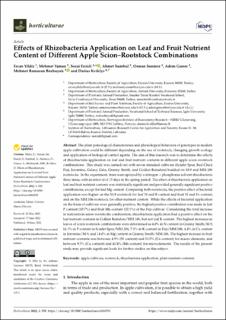| dc.description.abstract | The plant pomological characteristics and physiological behaviors of genotypes in modern apple cultivation could be different depending on the use of rootstock, changing growth ecology and application of biological control agents. The aim of this research was to determine the effects of rhizobacteria application on leaf and fruit nutrient contents in different apple scion–rootstock combinations. This study was carried out with seven standard cultivars (Scarlet Spur, Red Chief, Fuji, Jeromine, Galaxy Gala, Granny Smith, and Golden Reinders) budded on M.9 and MM.106 rootstocks. In the experiment, trees were sprayed by a nitrogen + phosphorus solvent rhizobacteria three times, with an interval of 15 days in the spring period. The effect of rhizobacteria application on leaf and fruit nutrient contents was statistically significant and provided generally significant positive contributions, except for leaf Mg content. Comparing both rootstocks, the positive effect of bacterial application was higher on the M.9 rootstock for leaf N and B content and fruit N and Fe content, and on the MM.106 rootstock for other nutrient content. While the effects of bacterial application on the basis of cultivars were generally positive, the highest positive contribution was made in leaf P content (10.7%) and fruit Mn content (32.1%) of the Fuji cultivar. Considering the total increase in nutrients in scion–rootstocks combination, rhizobacteria application had a positive effect on the leaf nutrient contents in Golden Reinders/MM.106, but not leaf K content. The highest increases in leaves of scion-rootstock combinations were determined as 4.0% in N content in Granny Smith/M.9, 14.1% in P content in Scarlet Spur/MM.106, 7.1% in K content in Fuji/MM.106, 4.4% in Ca content in Jeromine/M.9, and 14.0% in Mg content in Granny Smith/MM.106. The highest increase in fruit nutrient contents was between 4.9% (N content) and 13.5% (Ca content) for macro elements, and between 9.5% (Cu content) and 41.8% (Mn content) for microelements. The results of the present study may provide significant leads for further studies on this subject. | en_US |

